Using AI to Understand "The Big Beautiful Bill"
How will it impact the most vulnerable Americans?
In an age where legislation is increasingly complex and the stakes for everyday Americans grow ever higher, artificial intelligence is proving to be an essential tool for decoding policy. The so-called “Big Beautiful Bill” currently being debated in Congress—an omnibus piece of legislation touching housing, healthcare, education, and tax policy—spans thousands of pages and includes technical provisions that can elude even experienced analysts.
AI-powered deep research tools, such as Google’s Gemini, allow advocates, journalists, and citizens to interrogate the full text of the bill in real time, compare it to existing statutes, and identify language that would disproportionately affect vulnerable populations. These tools can simulate queries once reserved for legislative aides: Who benefits? Who pays? What are the long-term implications?
Traditionally, understanding the ripple effects of federal legislation has depended on think tanks, partisan summaries, or overworked legislative staff. This bottleneck has perpetuated opacity and often left the public reliant on shallow soundbites. AI changes this dynamic. With the ability to instantly extract, summarize, and analyze vast amounts of legal and economic data, AI tools bring transparency to the legislative process.
In my own analysis using Gemini, I was able to isolate how changes to the federal housing voucher program buried in Section 418 would shift funding away from urban centers toward less densely populated areas, disproportionately harming low-income renters in cities. Such insights—once the domain of institutional insiders—are now accessible to lawyers, advocates, and even individual constituents equipped with the right tools.
But transparency alone is not enough; AI can be used to tell the truth, especially when it challenges political spin. While proponents of the Big Beautiful Bill tout it as a victory for the working class, AI-powered breakdowns reveal regressive tax adjustments and cuts to direct cash assistance programs that would place greater burdens on the poorest Americans. AI deep research tools are not merely accelerants for policy wonks—they are instruments of democratic accountability. They offer a path to public understanding and resistance when the legislative process is shaped more by influence than equity. As we navigate the future of American lawmaking, AI can and should be wielded as a flashlight—not a fog machine.
I used Google Gemini Deep Research to analyze the BBB and its impact on low-income Americans. My results are here.
I created a chart to summarize the results:
This use case for AI brings transparency to our broken legislative process, and expands the reach of democracy.
Let's embrace it and use it to improve our world.





